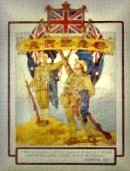|

THE
ANZAC
TRADITION
The ideals of courage,
endurance
and mate
ship
that are
still relevant
today
was
established
on
25 April 1915
when the Australian and New Zealand Army
Corps
landed
on the
Gallipoli Peninsula.
It was the start of a campaign that lasted
eight
months
and
resulted
in some
25,000
Australian
casualties,
including
8,700
who were
killed
or died
of
wounds
or
disease.
The men who served on the Gallipoli
Peninsula
created
a
legend,
adding
the word
‘Anzac’
to the
Australian
and
New
Zealand
vocabularies
and
creating
the
notion
of the
Anzac
spirit.
In 1916, the first anniversary of the landing
was
observed
in
Australia,
New
Zealand
and England
and by
troops
in
Egypt.
That
year, 25
April,
was
officially
named
‘Anzac
Day’
by the
Acting
Prime
Minister,
George
Pearce.
By the 1920s, Anzac Day ceremonies were held
throughout
Australia.
All
States
had
designated
Anzac
Day as a
public
holiday.
Commemoration
of Anzac
Day
continued
throughout
the
1930s
and
1940s
with
World
War II
veterans
joining
parades
around
the
country.
In the
ensuing
decades
returned
servicemen
and
women
from the
conflicts
inMalaya,
Indonesia,
Korea
and Vietnam,
veterans
from
allied
countries
and
peacekeepers
joined
the
parades.
During the 1960s and 1970s the number of people attending
Anzac
Day
marches
fell as
Australians
questioned
the
relevance
of Anzac
Day.
However,
in the
1990s
there
was a
resurgence
of
interest
in Anzac
Day,
with
attendances,
particularly
by young
people,
increasing
across
Australia
and with
many
making
the
pilgrimage
to the
Gallipoli
Peninsula
to
attend
the Dawn
Service.
ANZAC day is one of
Australia's
national
days,
and it
remains
a day
that
many
Australians
identify
with -
even as
the old
diggers
fade
away.
ANZAC Day has evolved over the years. Very
few of
those at
home in
1916 on
the
first
anniversary
would
have
made
much the
day.
Of
course
there
were no
troops
to
cheer.
Churchmen
organized
some
commemorative
services
and to
these
were added,
no
doubt,
many
private,
personal
recollections.
In
London
the
ANZAC
took
over,
briefly.
The
Australian
high
commission
planned
an
elaborate
celebration
that
included
a march
of
Australian
troops
through
the
heart of
the
capital
and
culminating
in a
service
at
Westminster
Abbey
attended
by the
King and
Queen.
Newspapers
encouraged
Londoners
to turn
out in
large
numbers
to give
the
Australians
a
heroes'
welcome
and
asked
women to
bring
flowers
to throw
at the
troops.
The
success
of the
march
rewarded
these
exhortations.
So great
was the
crush of
the
crowd
that the
ANZAC
was
unable
to march
in
formation
but
walked
in
groups,
acknowledging
the
affection
and
applause.
In the later war the Australians within their
own
units,
marked
usually
by a
church
parade
and a
special
dinner,
kept up
each
year’s
ANZAC
day.
Troops
of other
nations
also
wanted
to share
the day
with the
Australians
as W.E.
Dexter,
the
chaplain,
recorded
in his
diary.
He had
come
across
two
Pommies
(British
soldiers)
walking
in
Bapaume
on ANZAC
Day
1917, as
drunk as
could
be.
Dexter
told the
men to
go home
to bed:
"Excuse
him,
sir",
one of
them
said,
"He's
been
keeping
up
ANZAC".
"It
seems to
bid
fair",
Dexter
predicted,
"to
become a
universal
excuse
for a
bust".
At home
the day
continued
to be
marked
by
church
services
and
school
commemorations
and, as
War
memorials
began to
be built
even as
the war
continued,
there
were a
few
wreath-laying
ceremonies.
|

|

|
|
Australia |
New
Zealand |
Australian troops returned to no great
victory
parades,
partly
because
they
came
back so
irregularly
during
1919 and
1920.
Also
because
of the
influenza
pandemic
of early
to mid
1919,
which
stopped
people,
mixing
together
in large
numbers.
Units
and
associations
commemorated
ANZAC
Day
privately,
rather
than in
a major
public
way in
the
early
twenties.
The point of the march, in
Sydney
or the
bush,
was to
gather
all the
returned
men
together
and to
draw
them to
one
central
spot, a
shrine
or
memorial,
for a
service
of
commemoration.
The original ANZAC has grown very old, most
have
died
off, but
they
will
never be
forgotten.
The celebration continues to change and
evolve
but it
still
retains
a great
significance
for many
millions
of
Australians
of all
generations
and now
diverse
ethnic
backgrounds,
with
Poles
and
other
Europeans
and the
Vietnamese
proud to
march
beside
the
diggers.
Australians will continue to remember that
first
ANZAC
Day in
dawn
services
and
other
commemorative
events.
Let us
hope
too,
that
they
will
never
forget
what
Australians
endured
and
achieved
in
France
and Belgium,
the
Middle
East, New
Guinea
and the
Islands,
Malaya,
Borneo,
Indonesia,
Korea
and
Vietnam.
Let us
hope
that
they
will
reflect
on the
futility
and
horror
of war
and vow
each
ANZAC
Day that
there
should
be no
more of
it.
|